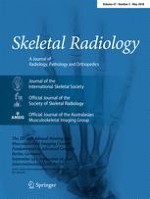01-11-2004 | Scientific Article
Intersection syndrome: MR imaging with anatomic comparison of the distal forearm
Published in: Skeletal Radiology | Issue 11/2004
Login to get accessAbstract
Objective
To correlate the anatomic and MR imaging characteristics of the area of intersection of the first and the second dorsal extensor tendon compartments (DETC) in the distal forearm in an attempt to improve the design of MR imaging protocols used for the evaluation of intersection syndrome.
Design and patients
Ten forearms of nine cadavers underwent MR imaging in the axial and sagittal-oblique planes before and after tenography with direct injection of a gadolinium-containing contrast agent into the first DETC in four forearms, the second DETC in four forearms, and both compartments in the remaining two forearms. The area of intersection between the first and second DETC was identified in each case as well as its distance from Lister’s tubercle. Subsequently all forearms were sectioned in the axial (8 forearms) or sagittal-oblique planes (2 remaining forearms) to parallel the imaging planes. Detailed examination of each of the anatomic slices was performed in a search for anatomic variations and for possible anatomic connections of the tendons sheaths. One forearm was dissected to identify the area of intersection.
Results
The area of intersection between the first and second DETC occurred between 3.5 cm and 4.8 cm (mean 4.18 cm) proximal to Lister’s tubercle. After tenography, gadolinium solution was noted in the third DETC in two of four specimens in which the second DETC was injected and in one of two specimens in which both the first and second DETC were injected. Extension of the gadolinium solution between the first and second DETC was noted during isolated injections of either compartment, although this finding may have related to iatrogenic injection effects. The axial plane was the most valuable for assessment of the area of intersection of the first and second DETC.
Conclusion
MR imaging is a noninvasive method that can be used for the evaluation of distal forearm and wrist pain. Standard wrist protocols do not include the area of intersection between the first and second DETC and, in those cases in which intersection syndrome is suspected, the MR examination must be tailored to include the forearm.





